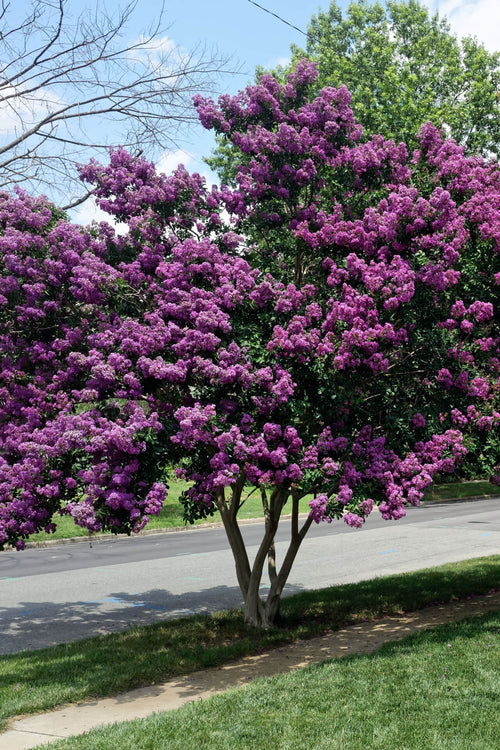Crepe Myrtles: A Kaleidoscope of Beauty for Your Garden
In the world of ornamental trees and shrubs, few species can rival the versatility, beauty, and charm of Crepe Myrtles (Lagerstroemia spp.). With their vibrant blooms, stunning colors, and diverse growth habits, Crepe Myrtles have captured the hearts of gardeners and landscapers alike. Whether you're aiming for a tranquil retreat, a burst of summer color, or an elegant focal point, these remarkable plants offer a wide range of options to suit every garden's needs.
A Tapestry of Sizes and Shapes: One of the most appealing characteristics of Crepe Myrtles is their remarkable diversity in size and shape. From small shrubs to more giant trees, they offer options that can fit into any garden setting. Dwarf varieties, such as the 'Pocomoke' and 'Chickasaw,' stand at a diminutive 2 to 3 feet tall, making them perfect choices for container gardening, front borders, or even bonsai enthusiasts. These smaller cultivars burst into vibrant bloom like their larger counterparts, proving that good things come in small packages.
For those with more space, mid-sized crape myrtles like the 'Natchez' and 'Tuscarora' balance compactness and grandeur. Typically reaching 10 to 20 feet, these varieties are well-suited for small gardens, hedges, or focal points in mixed borders. Their moderate height allows for easier maintenance while providing a spectacular floral display.
The taller Crepe Myrtle varieties are the show's stars for more significant landscapes or those seeking to make a bold statement. Reaching heights of 20 to 30 feet or more, types like the 'Muskogee' and 'Dynamite' create an awe-inspiring presence, commanding attention with their impressive stature and breathtaking blossoms. These tall cultivars are often used as shade trees, street trees, or anchor plants for expansive gardens, where they contribute both beauty and a sense of scale.
A Paint Palette of Colors:
One of the defining features of Crepe Myrtles is their ability to paint the garden with an array of mesmerizing colors. From pastels to bold and vibrant hues, the spectrum of Crepe Myrtle blossoms covers nearly every shade imaginable. The classic whites, pinks, and reds dominate the color palette, offering options that cater to a wide range of aesthetic preferences.
Red-blooming Crepe Myrtles, like the aptly named 'Dynamite,' offers a fiery statement that demands attention. The rich red blossoms are synonymous with passion and vitality, making them a fantastic choice for creating dramatic focal points. These varieties create a striking contrast that adds depth and intensity to any garden scene.
Growth Habits for Every Landscape:
Beyond their size and color, Crepe Myrtles exhibit diverse growth habits, further enhancing their suitability for various garden designs. Understanding these growth patterns can help you select the perfect Crepe Myrtle for your landscape.
Single-Trunk Trees:
Many Crepe Myrtle varieties can be trained to develop a single, sturdy trunk, lending them the appearance of a small tree. This growth habit is perfect for those seeking a formal focal point or an elegant addition to their garden. The single-trunk trees create a sense of verticality and structure that can be especially appealing in more significant landscapes.
Multi-Trunk Trees:
Crepe Myrtles are known for their stunning multi-trunk forms, where multiple slender stems arise from the ground, creating a graceful and natural appearance. Multi-trunk varieties are excellent for adding texture and visual interest to the garden. These forms can be especially effective when used as standalone specimens or in small groups, allowing their architectural beauty to shine.
Shrubs and Bushes:
Some Crepe Myrtle varieties exhibit a more shrub-like or bushy growth habit. These types are versatile additions to any landscape, suitable for hedges, borders, or mass plantings. Their compact nature makes them easy to manage and shape, allowing for creative pruning and artistic expression.
Caring for Crepe Myrtles:
Here are some tips to keep in mind:
- Pruning: Crepe Myrtles benefit from regular pruning, typically performed during late winter or early spring. When pruning, avoid the controversial practice known as "crepe murder," which involves severe cutting back of branches. Instead, opt for careful pruning to maintain the plant's natural beauty.
- Watering:
- While Crepe Myrtles are generally drought-tolerant once established, they benefit from consistent watering, especially during periods of extended dryness. Water deeply and infrequently to encourage profound root growth. Applying a layer of mulch helps retain soil moisture and regulate temperature.
- Fertilization: Providing the proper nutrients is crucial for vibrant blooms. Use a balanced fertilizer in the spring before new growth begins. Avoid excessive nitrogen, as it can lead to lush foliage at the expense of flowers.
- Pest and Disease Management:
- Crepe Myrtles are relatively resilient, but they can be susceptible to aphids, powdery mildew, and other pests and diseases. Regular inspections are crucial to preventing infestations. Choose disease-resistant varieties to reduce the likelihood of issues.
- Winter Protection:
- Some Crepe Myrtle varieties may benefit from winter protection in colder climates, especially during their early years. Applying mulch around the base and wrapping the branches in burlap can help shield the plant from freezing temperatures and harsh winds.
Conclusion: A Garden Enriched by Crepe Myrtles:
Crepe Myrtles offers an incredible array of sizes, colors, and growth habits, making them a versatile and captivating choice for any garden. From the charming dwarf varieties that fit snugly in small spaces to the majestic trees that command attention in more significant landscapes, these plants have something to offer every gardener. Their stunning blossoms, vibrant foliage, and unique growth patterns add depth, character, and beauty to any outdoor setting.
Whether you're aiming to create a serene oasis, a vibrant burst of color, or an inviting space for gatherings, Crepe Myrtles can play a starring role in bringing your vision to life. These plants can transform your garden into a living masterpiece with careful selection, thoughtful care, and creativity.



















































